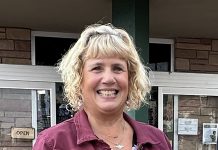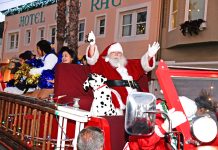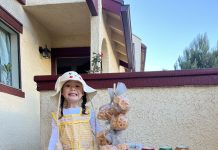Just a few hours before boarding the Catalina Express, Carol Highsmith was on the set of The Tonight Show with Jay Leno, photographing the host, who will step down next year when the Burbank set will be demolished and the show moved to New York.
Catalina Island and Leno’s set were just two stops on an epic journey. Highsmith, along with her husband, Ted Landphair, is on a quest that will take her to all 50 states, photographing buildings, train stations, lighthouses, parades and local traditions which may or may not be found 100, 200 or 300 years from now.
Just a few hours before boarding the Catalina Express, Carol Highsmith was on the set of The Tonight Show with Jay Leno, photographing the host, who will step down next year when the Burbank set will be demolished and the show moved to New York.
Catalina Island and Leno’s set were just two stops on an epic journey. Highsmith, along with her husband, Ted Landphair, is on a quest that will take her to all 50 states, photographing buildings, train stations, lighthouses, parades and local traditions which may or may not be found 100, 200 or 300 years from now.
Her photos, tens of thousands of them, will be donated to a permanent collection in the Library of Congress, where they will be available to download for free to anyone interested.
The digital works will go into the Library of Congress’s Prints and Photographs Online Catalogue, joining other prestigious collections like the epic works of Civil War photographer Mathew Brady and Depression-era chronicler Dorothea Lange – the vicissitudes of life permitting.
After all, Highsmith, at 67, is in the fourth year of her 16-year quest, averaging three states a year and 2,000 images a state, culled from about 5,000 images shot per state.
In California, she and Landphair, residents of Takoma Park, Maryland, were particularly interested in the Island “26 miles across the sea” via the famous lyrics of the song “26 Miles” by the Four Preps. “When I was a young girl in Minneapolis I heard that song and never conceived that I would actually be here,” Highsmith said while enjoying a Catalina Island Conservancy Jeep Eco Tour of the Island.
She was impressed with Avalon’s charms. But she’s cautious about the future. “I’m not sure if Catalina will stand the test of time,” she says without hesitation. “Somewhere along the line, will somebody decide that high-rise buildings will look a heck of a lot better than what we have now?”
Venturing out into the Island’s interior, she was shown how the Conservancy was protecting and restoring the land through a balance of conservation, education and recreation.
She photographed Grant Powell, the Conservancy’s invasive plant technician, and Rebecca Cano, horticultural technician, in the process of eradicating non-native harding grass, and was impressed with what she saw. “The Conservancy should be proud of the way it is protecting the Island,” she remarked.
She photographed Thompson Reservoir, Middle Ranch and the Airport in the Sky. When photographing Eagle’s Nest Lodge, she said she was appreciative that it will be relocated and rehabilitated to its new home at the intersection of Middle Ranch and Skull Canyon Roads as an interpretive and educational center. Like Highsmith, the Conservancy is also archiving Catalina landscapes and architecture on canvas with its “Catalina: The Wild Side” project, in which renowned plein air artists capture the Island’s peaks, valleys and coves.
Although the majority of the artwork will be sold to the public on June 22 at the art show and sale at the Catalina Island Country Club, several of the pieces will be retained by the Conservancy to add to its growing collection that documents the Conservancy’s conservation efforts and progress in habitat restoration.
“I am thrilled that the majority of the Island will not be touched, ever! That is superb,” she exclaimed. “There are just not that many untouched places left in the civilized world and in America. I am thrilled to be here.” Highsmith’s photos are headed to the Library of Congress, where they will be, as she puts it, on the world’s stage. “Some day in the distant future, other islands can say ‘We should be like Catalina Island.’”
To see examples of Highsmith’s photos that document America, visit: www.carolhighsmithamerica.com.










